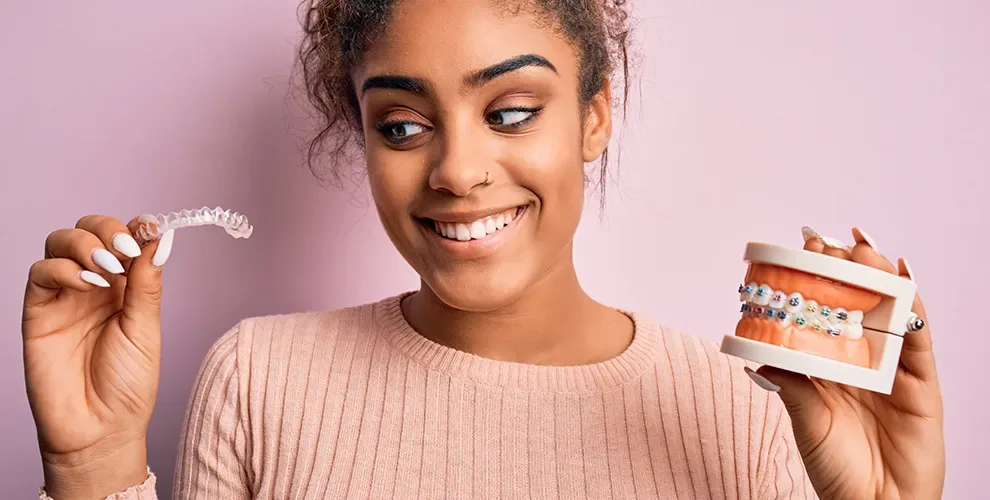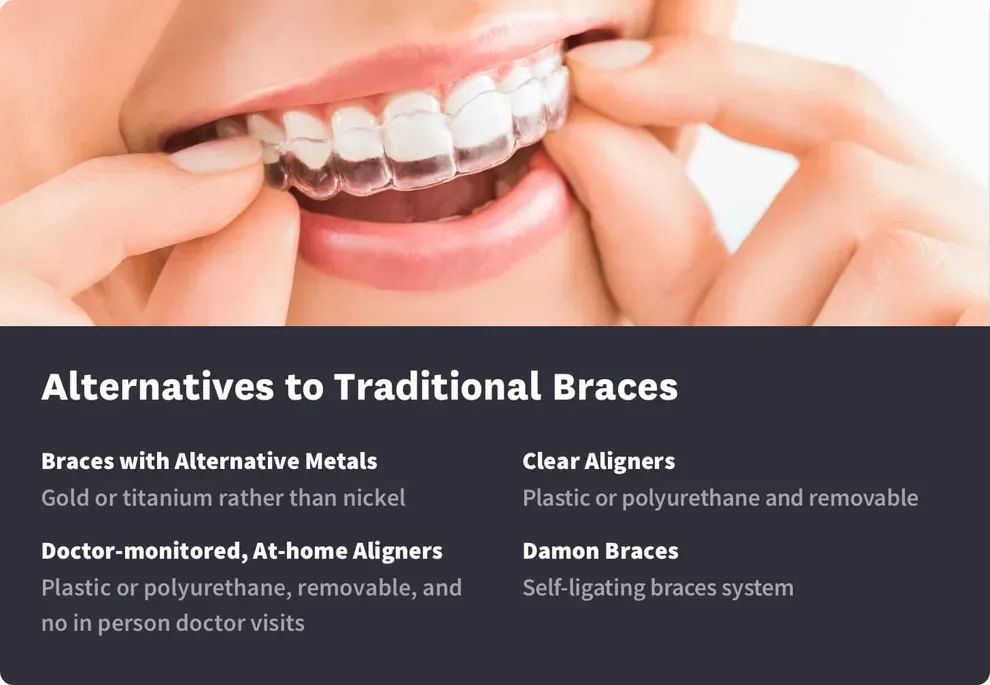How ‘Traditional’ Braces Stack Up

Table of Contents
- History of Traditional Braces
- Are Braces the Best Choice?
- Other Options
- The Right Choice for You in 2022
The term braces usually brings to mind metal brackets glued to your teeth and wired together. While this form of dental alignment is still commonly used, there are dozens of other options available to both adolescents and adults who want to straighten their teeth.
Adults in particular may prefer something much less visible than metal braces, such as aligners. Thanks to developments in the field, aligners can offer a more attractive path to straight teeth for those with mild to moderate misalignments. For more severe cases of misalignment, traditional braces might still be the best bet.
You’ll need an assessment from an orthodontic professional to determine if “traditional” braces are the best option for you in 2022. Aligner companies will assess impressions of your teeth to determine if aligners will work well for you.
If your case is too severe for aligner correction, you should visit an orthodontist to determine if traditional braces will straighten your teeth. In some cases, additional tools may be needed, such as headgear or rubber bands, to adequately correct your misalignment issues.
The history of traditional braces.
Since there are so many options like clear aligners, ceramic braces, and permanent retainers available to adults who want straighter teeth, you may wonder if there is even a point in traditional braces. They may seem outdated compared to newer, less visible options. However, traditional metal braces still have an important place in orthodontic treatment.
Archaeologists have found evidence of ancient humans using metal wires to straighten teeth, so the idea behind braces has been around for thousands of years. The current technology behind braces was officially developed in the 18th century.
A book titled The Surgeon Dentist, published in France in 1728, offered a chapter on straightening teeth. A book published in 1757 titled The Dentist’s Art offered recommendations on devices that could be used to align crooked teeth. By 1819, the first wire crib was developed and used.
The term orthodontia was not used until 1841. By 1843, gum elastics were developed and used by specialized dentists whose field would become orthodontics. Rubber bands were implemented in orthodontic practices in 1850. The first medical article specifically covering orthodontics was published in 1858, and the author then completed a book on the subject in 1880.
Finally, the American Society of Orthodontia was formed in 1901, leading to establishment and certification of specific dental schools to study and promote orthodontic treatment. Braces primarily wrapped around the teeth. Once secured, they applied a certain amount of force until the misaligned teeth moved into alignment.
In the 1970s, direct bonding braces (the current idea behind traditional braces) were developed, in which the braces were bonded to the front of the teeth.
Lingual bonding, which involves putting metal or ceramic braces on the inside rather than outside surface of the teeth, became more popular later.
Are traditional braces always the best choice?
If you need braces as an adult, you probably do not want them to be obvious. You have a lot of other options besides traditional braces that can offer you a more understated and often faster path to straight teeth.
If your teeth misalignment issues are mild to moderate, you have the most options for straightening treatments. You can choose from a range of understated options, such as aligners, removable retainers, or even bonding to fix small gaps between the teeth.
In some cases, you will still need traditional braces. While the term “traditional” refers to a certain type of braces, this technology has also evolved. Today’s traditional braces are better and less obtrusive than braces from decades ago.
If you go for traditional braces, you are still less likely to have the “metal mouth” that you might have had as a child. Metal braces that are bonded to the outside of your teeth are made from lighter, higher-grade stainless steel than in prior decades. The wires attaching them together are stronger and thinner too.
There are also variations on this type of braces that are much more unobtrusive than metal. For example, ceramic braces are made from clear, transparent, or white material so they match your teeth, making them much less obvious.
With lingual braces, smaller metal or ceramic braces are bonded to the inside of your teeth, rather than the outside, so they are not apparent when you smile. Lingual braces still use traditional brackets and wires, so having these near your tongue can be uncomfortable. There is usually an adjustment period as you learn to talk, eat, and drink with these devices on the back of your teeth.
With better options for clear aligners or retainers after braces, you may not need to wear traditional braces for very long. Even if you have a severe case that necessitates an initial course with traditional braces, you may be able to progress to aligner treatment. This means you’ll wear traditional braces for a shorter period of time overall, correcting your most severe issues. More moderate adjustments can then take place with clear teeth aligners.
When you think of traditional braces, you may only think of a mouth filled with metal, but with advances in braces technology make them less visible, faster acting, and a good option for many people.

Other options to straighten teeth.
With advances in metal, ceramic, and plastic strengths, there are more options for teeth straightening than ever before. Alternatives to traditional braces include:
If you are allergic to nickel, which is involved in making steel, your orthodontist may give you the option of titanium or gold-plated braces. Like traditional braces, gold or titanium braces are very noticeable. Some people simply like the look of them.
This specific brand of orthodontia self-ligates, so you do not need pieces of metal or ceramic glued to your teeth. They also use a sliding device to tighten, and they typically work faster for moderate orthodontic needs than traditional braces.
Mild and moderate misalignment can be treated with clear plastic or polyurethane aligners. This trend began with the rapid rise of Invisalign, but now several other brands offer aligners combined with technological advances. Aligners are a series of retainer-like devices that mold to your teeth, putting pressure on them to straighten them.
As aligners have become the most popular orthodontic option, there are some companies that offer remote orthodontic consultations and a series of customized, mail-order aligners. Doctor-monitored, at-home aligners allow you to straighten your teeth without the need for in-person appointments. This often results in a lower price point as well as a faster treatment timeline.
These aligners work best for mild to moderate cases. Severe cases most often require traditional braces as well as adjunct treatment to fully straighten the teeth.
According to the American Association of Orthodontists, the main benefit of traditional braces is that they are not removable. While this means they require specific approaches to oral hygiene, so you do not develop cavities underneath the brackets or gum disease, the constant pressure on your teeth means better alignment that lasts longer.
More advanced options for teeth straightening in 2022, such as aligners, require that customers fully comply with the treatment program and wear the aligners for the specified amount of time. customer compliance is obviously easier to ensure with traditional braces since customers are unable to remove the braces at will.
The right choice for you in 2022.
All of these devices to straighten teeth involve a process called bone remodeling. This forces membranes around your teeth to reshape, allowing your teeth to align differently for a better appearance.
Depending on the degree of your misalignment, aligners may be adequate to correct your smile. Since they are cheaper, more comfortable, easier to use, and may give faster results than traditional braces, they are often the preferred choice of customers.
If you have specific medical needs involving braces, or you have teeth that are greatly misaligned, traditional braces will usually work better for you than other options. It all depends on your particular case.
With so many teeth-straightening options in 2022, it’s worth your time to explore what will work for you. Get an assessment from an aligner company to determine if you are a good fit for their product. This generally involves taking impressions of your teeth at home. A professional will then assess your teeth and conclude if aligners can work well for you.
If it’s determined you aren’t a good candidate for aligners, it’s time to see an orthodontist. They will assess how traditional braces will work for you.
